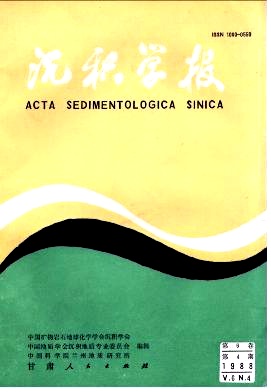USEING MOLECULAR FOSSIL INDICATORS FORANALYSIS OF PALEOENVIRONMENTSOF A SEDIMENTARY BASIN,IN EASTEN CHINA
- Received Date: 1987-04-25
- Publish Date: 1988-12-10
Abstract: In this paper, not only the already well known molecular fossil indicators have been summarized, but also some new ones are proposed for analysis of pale-oenvironments of a sedimentary basin, and the adaptability of them for this is verified and reviewed. Molecular fossils are biogenic molecules, coming from the remains of organism in sediments and being of a certain implication in sedimentology or/and paleontology. Although experienced changes in diagenesis, yet they keep the carbon skeleton inherited from their biological precursors. Only n-alkanes, isoprenoid hydrocarbons, steranes and terpanes are detailed in this paper. l.Up to now, n-alkanes have been effective indicators of the sourceof organic matter in sedimentary rocks and crude oils. Generally, if the organic matter is made up mainly of the" terrigenous"type, it reflects a sedimentary environment of fluvial, or deltaic, or marginal facies in a basin. On the contrary, if the organic matter is made up mainly of the " autochonous in basin" type, it reflects an environment of central basin facies or lacking terrigenous substances. 2.A preference of even over odd carbon number n-alkanes ( i.e.OEP or CPI<1) is an indicator or reducing-even strong reduing environments. It is shown, by a systematic comparison of the contents of pyrite-Fe, a reductive authigeni c mineral indicator, in Fe-containing minerals with the CPI of the rocks from the Lower Tertiary in Dongpu Basin,that there is a quite good correlation between them (Fig.2,a). For the samples with CPI<1, their contents of pyrite-Fe in Fe-con taining minerals all are over 50%. As the CPI values are getting smaller, the contents of pyrite-Fe higher; furthermore the correlation between them is much better. It is indicated by the comparison that the OEP or CPI indicator to reduc-ti on,even strong reduction would be adaptible to paleoenvironmental analysis, least in our cas es. 3.A predominance of n-C22 in a-alkanes may be an indicator of hypersalino environments. There are the predominances of n-C22 in many rocks and crude oils formed in hypersaline environments from the lower Tertiary basins of Dongpu and Subei (Fig.3 ).However, the evaporites (Fig.3,No.84009, 84010 and 84016)and,in a series of the rocks in an order of increasing salinity formed in hypersaline environments(Fig.3, from No. 84052 to 84055), No. 84052 and 48053 have no such a predominance, which shows that the n-C22 predominancn in n-alkanes may be an indicator of hypersalinity only within a certain range. 4.Isoprenoid alkanes such as C20(phytane), C25,C30 and C40 are the indicators of archaeodacteria activity.In the basins of Dongpu and Subei, as well as some of other Cenozoic and Mesozoic basins of China, strong predominances of phytane have been found, the content of Ph is several to tens times that both of Pr and n-C18 in a rock. Such a strong predominance of phytane probably is a molecular indicator of extreme halophile archaeobacteria activitiy. The C16-C30, esp. the C25, C17 etc. regular isoprenoid alkane have been found in the basins mentioned above (Fig.4). They may be a molecular indicator of the activities of thermoacidophiles or extreme halophiles. 5.Pr/Ph is an oxidation-reduction indicator. It is found, by a systemtic comp-arision between the Pr/Ph and the contents of pyrite-Fe like section 2, that the Pr/Ph of the rocks from Dongpu Basin are18 and Ph》Pr). On the contrary, generally, there is no such a predominance in the rocks forned under relatively freshening conditions. 7.A relativaly high abundance of C25 regular
| Citation: | Li Renwei, Li Zhe, Wang Zhizhen, Lin Daxing. USEING MOLECULAR FOSSIL INDICATORS FORANALYSIS OF PALEOENVIRONMENTSOF A SEDIMENTARY BASIN,IN EASTEN CHINA[J]. Acta Sedimentologica Sinica, 1988, 6(4): 108-119. |






 DownLoad:
DownLoad: